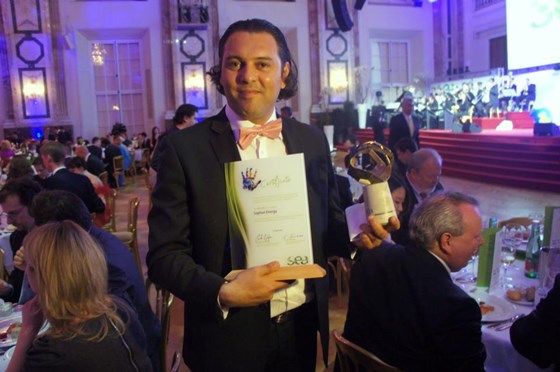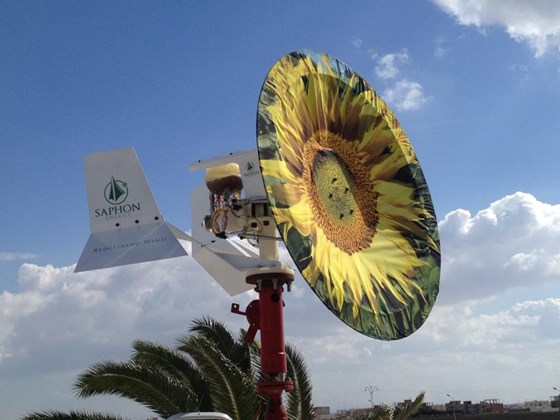Interviews: Sailing Close to the Wind
Interview with Anis Aouini Inventor of The Saphonian
Interview with Anis Aouini Inventor of The Saphonian
Interviewed for Med Voices by Khadija Ghezaeil
MedV: It feels great and Med Voices is deeply honored to speak to the inventor of the Saphonian, the co-founder and Chairman of Saphon Energy, engineer Mr. Anis Aouini! Congratulations for the SEA "Best Idea" Award 2013.
A.A: Thank you Med voices, Saphon is glad to have been honored with the “Best Idea” in the Sustainable Entrepreneurship Award 2013, in Vienna. 260 projects from 30 countries were in competition. Our participation and award was the first granted to a Tunisian innovation so, I would like to say that this is Tunisia that has been honored through Saphon Energy.
MedV: Great! So far, Mr. Anis, The Mediterranean area and Tunisia in particular have not been advanced in the field of innovative technologies. In a universe calling for a global action to make alternative world possible, it is high time we opted for alternative energies that are avant-garde and revolutionary. Saphon Energy is a leading brand in this domain. What is the Saphon Energy project seeking to achieve?
A.A: Even though the Mediterranean area, the South to be more specific, is not considered as an area conductive to innovative technologies, the first step for Saphon is to show that this assumption can be refuted. Actually, we do believe in Saphon, that the South of the Mediterranean and especially Tunisia, already got the elements to be an innovative environment; but such environment needs to meet open-minded partners to support innovative projects. It is true that Saphon has been lucky to find partners able to understand the potential of the Saphonian during the development.
MedV: Can you specifically tell us what is the Saphonian, how it started, was it tricky, uncomplicated, though it cannot for sure be that easy?
What has been your biggest challenge so far?
A.A: The Saphonian holds its name from our Punic roots. Baal Saphon was the divinity of wind in the ancient Carthage. As a breakthrough technology, the Zero-Blade technology has to be named differently.
The most difficult challenge at the very beginning was to reconsider the current technology. Indeed, during the last decades manufacturers have spent a lot of money to improve the wind turbines. The researches have focused on 3 axes: the scalability, strength of the materials and the blades’ design; whereas, I’ve always been convinced that the solution did not reside in the improvement of these elements. That was the biggest challenge, because I had to think out of the box to find a more efficient solution. Such an exercise demands a certain psychological resistance because I had to fight against the odds, keeping my own convictions.
MedV: Great! Generally, ground-breaking ideas start in on a primary inspiration. Concerning the saphon project, what was your inspiring muse?
A.A:
After a deep analysis of the current technology I have observed that the conventional wind turbines are subject to a set of drawbacks. Most of these drawbacks come from two things: the blades and the rotation. That is the reason why, the Saphonian had to be designed bladeless and without rotation.
First of all, the presence of blades submits automatically the machine to the Betz limit, according to which the most perfect wind converter never could convert more than 59% of the wind harnessed. Such loss is increased with electro-mechanical and aerodynamic losses due to the components themselves. In the Saphonian case, the blades have been replaced by a sail shaped body inspired from sail boats, as a glance to our Carthaginian heritage. As you may know it, the sail boat is still the most efficient system for converting wind energy. Of course, unlike the sail boat, the Saphonian is not mobile. Then, the main challenge was to find or discover, a motion able to harness the wind as a sail boat while remaining fixed. This motion, used by the Saphonian, is called the 3D-knot-motion and is applied for the first time in mechanic. The 3D-knot-motion is inspired from nature (fish tails, or bird wings). At Saphon Energy, we have the firm conviction that the technologies shall be, in so far as is possible, compliant with bio-mimetic principles; that’s why the Saphonian is a wind converter system inspired from nature to satisfy nature. In the same line, the Saphonian has been devised to benefit of high landscape integration potential, as required by bio-design rules.
MedV: Zero-blade? Can you explain this? Is the technology the same as used in London Array, the widely known UK offshore wind farm? London array has 175 turbines. Though its first turbine was installed in January 2012, first power was achieved in October that year and the final turbine was installed in December 2012. The project is said to be fully ready by Spring 2013.
A.A:
The main specificity of the Saphonian is to be bladeless and rotationless. I know that this might shock because all the conventional wind turbines are designed exclusively with blades having a rotating motion. As a consequence, the Saphonian is very different from the London Array wind turbines. To understand why the Saphonian is a bladeless wind converter.The wind is harnessed by a curved sail-shaped body which follows a back and forth 3D knot motion. This motion converts the majority of the wind kinetic energy into mechanical energy by exciting pistons located in the back of the body. These pistons are connected to a hydraulic system to convert the mechanical energy into hydraulic pressure and then, to electricity.
By removing the blades, the Saphonian has set itself free from Betz limit, deleted the airwaves disturbances, and limited accident risks. In addition, the Saphonian also removed noisy components as the gearbox and the hub. The removal of these components allows saving about 45% of the manufacturing costs. Besides, the use of a sail shaped body makes the Saphonian easily identified by birds as an obstacle to avoid, and allows a better landscape integration.
MedV: The more turbines are implemented, the more huge differences are made to the environment, is it true?
A.A: It is obvious that the use of wind turbines avoids using a certain quantity of polluting fossil energy. Of course, the results would be more perceptible if wind turbines were more largely adopted. Currently, the wind industry’s production of electricity is estimated at about 1,3% of the global electricity. This shows that the wind industry still has a huge room of improvement. Indeed, the current technology is still to dependant on the wind intermittency, constraining states to support the sector via public subsidies. Nevertheless, we do believe at Saphon that wind energy, and renewable energies, are vital for a sustainable environment change.
MedV: Do you think that Saphon may help in providing a reliable electricity supply to those isolated and disadvantaged local regions?
A.A: Actually, by converting the kinetic energy into mechanical, then hydraulic and electrical, the Saphonian offers a lot of options. One of the most important options is the storage of the energy coming from the wind. Nowadays, the wind turbines cannot convert the totality of the kinetic energy, besides if this energy is not immediately converted into electricity, it is lost forever. Engineers tried to storage such energy via batteries, but this solution is either expensive or not adapted to high power. That is why wind turbines still need to be connected to the grid to be relieved if there is no wind. Whereas the Saphonian, allows storing the hydraulic energy when the wind blows in excess and converting this energy into electricity if needed. By this way, isolated areas or sites can be self sufficient at an affordable price.
MedV: Saphon new bladeless Wind Turbine are claimed to be twice as efficient as conventional Designs. It is also money-saving and ecologically-friendly. In light of these benefits, I really ponder about, what the local administrations are waiting for before they embark on solid investments within this technology?
A.A: The local administrations are subject to specific procedures which are pretty long and very stringent. I guess we need to be patient. Anyway, Saphon keeps on working to promote the Zero-Blade technology worldwide and we have just been awarded in Austria and South Africa. The most important for us is to keep our course and bring the Saphonian to the market.
MedV: What do you hope Saphon will look like in a year's time?
A.A: The next steps for us are to jump from the pre-industrial stage to the industrial one and start selling our new Saphonian Wind Energy Converter to the Market. In order to do that, we are in process of considering partnership options to take our innovation to the market as soon as possible.
MedV: Thank you Mr Anis.
Comments: 0
There are no comments yet, be the first to write a comment!
Available for freelance


